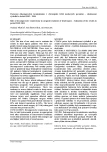Role of decompressive craniectomy in surgical treatment of head injury - evaluation of the results in period 2002-2004
Authors:
Vladimír Přibáň; Petr Řehoušek; Jiří Fiedler
Authors‘ workplace:
Department of Neurosurgery, Hospital České Budějovice
; Neurochirurgické oddělení Nemocnice České Budějovice a. s.
Published in:
Úraz chir. 16., 2008, č.2
Overview
Aim:
The aim of our study was to evaluate the results in head injury patients who were surgically treated using decompressive craniectomy.
Material and methods:
There were reviewed results of 66 patients in the period 2002–2004 one year after surgery. Mean age was 43.5 year, predominantly men (40). Admission level of consciousness, age, preoperative CT, time period between injury and operation, accompanying ijuries, peroperative findings and Glasgow outcme score one year after surgery were recorded. Decompressive craniectomy was usually perfomed as ipsilateral large hemispheral craniectomy (62 patients) bilateral hemispheral craniectomy (2 patients) or bifrontal craniectomy (2 patients). Operation was alway supplemented by radial cuts of dura mater and duroplasty.
Results:
Key factor which influenced clinical outcome was the age of patients. Older patients had worse prognosis. Next prognostic factor was admission level of consciousness. There was tendency to worse clinical results in deep uncoscious admission patients. Nevertheless the results were not statistically significant. Time period between injury and operation affected ambguously the results. Emergent surgery within 6 hours was joined with good clinical outcome in 43% and delayed operations in 36%. The worst outcome was in acute surgery (6–24 h) when good outcome was present in 25%.
Conclusion:
Decompressive craniectomy enbles to hold intracranial pressure in appropriate level after exhaustion of conservative treatment. Good clinical outcome is joined with younger age and higher initial level of consciousness.
Key words:
head injury, decompressive craniectmy, age, intracranial hypertension.
Sources
1. Aarabi, B., Hesdorffer, D. C., Ahn, E. S. et al. Outcome following decompressive craniectomy for malignant swelling due to severe head injury. J Neurosurg. 2006, 104, 469–479.
2. Breasted, J. H. The Edwin Smith surgical papyrus. Chicago: University Chicago Press, 1930. 480 s.
3. Compagnone, C. H., Murray, G., Teasdle, G. et al. The management of patients with intradural post-trauamatic mass lesions: A multicenter survey of current approaches to surgical management in 729 patients coordinated by the European Brain Injury Consortium. Neurosurgery, 2005, 57, 1183–1192.
4. Cooper, P. R., Rovit, R. L., Ransohoff, J. A rappraisal. Surg Neurol. 1976, 5, 25–28.
5. Cushing, H. The establishment of cerebral hernia as a decompressive measure for inaccesible brain tumors; with the description of intramuscular methods of making the bone defect in temporal and occipital region. Surg Gynecol Obstet. 1905, 1, 297–314.
6. Hejčl, A., Bartoš, R., Humhej, I. et al. Dekopresivní kraniektomie v léčbě posttraumatického edmu mozku a přínos nových monitorovacích technik. Čas lék čes. 2007, 4, 307–312.
7. Hutchinson, P. J., Corteen, E., Czosnyka, M. et al. Decompressive craniectomy in traumatic brain injury: the randomised multicenter RESCUEicp study. Acta Neurochir Suppl. 2006, 96, 17–20.
8. Jaeger, M., Soehle M., Meixenbauer, J. Effects of decompressive craniectomy on brain tissue oxygen in patients with intracrainal hypertension. J Neurol Nerosurg Psychiatry. 2003, 74, 513–515.
9. Jennet, B., Bond, M. Assessment of outcome after severe brain damage: a. practical scale. Lancet. 1975, 1, 480–484.
10. Maas, A. I., Steyerberg, E. W., Murray, G. D. et al. Why have recent trials of neuroprotective agents in head injury failed to show convincing efficacy? A pragmatic analysis and theorethical considerations. Neurosurgery. 1999, 44, 1286–1298.
11. Marmarou, A., Anderson, R.L., Ward, J. D. et al. Impact of ICP instability and hypotension on outcome in patients with severe head trauma. J Neurosurg (Suppl.). 1991, 75, 59–66.
12. . Miller, J. D., Becker D. P., Ward J. D. Significance of intracranial hypertension in severe head injury. J. Neurosurg., 1977, 47, s. 503 – 516.
13. Mraček, Z. Význam velké dekompresivní kranitomie při edému mozku u těžkých kraniocerebrálních poranění. Rozhl chir. 1977, 56, 597–605.
14. Mraček, Z. Kraniocerebrální poranění. Praha: Avicenum, 1988. 304 s.
15. Navrátil, L. Dekompresivní kraniektomie u krniocerebrálních poranění – hodnocení přežití a jeho kvality po jednom roce od úrazu. Čes Slov Neurol Neurochir. 2007, 3, 294–301.
16. Sahuquillo, J., Arikan, F. Decompressive crniectomy for the treatment of refractory high intrcranial pressure in traumatic brain injury. Cochrane Database Syst Rev. 2006, CD003983.
17. Smrčka, M. et al. Poranění mozku. Praha: Grada, 2001. 272 s.
18. Teasdale, G., Jennett, B. Assessment of coma and impaired consciousness. A practical scale. Lacet. 2974, 2, s. 81–84.
19. Whitfield, P. C., Patel, H., Hutchinson, P. J. et al. Bifrontal decompressive craniectomy in the management of posttraumatic intracranial hypertesion. Br J Neurosurg. 200l, 15, s. 500–507.
20. Yamakami, I., Yamamura, A. Effects of dcompressive craniectomy on regional cerebral blood flow in severe head trauma patients. Neurol Med Chir. 1993, 33, s. 616–620.
Labels
Surgery Traumatology Trauma surgeryArticle was published in
Trauma Surgery

2008 Issue 2
Most read in this issue
- TREATMENT OF UNSTABLE MANDIBULAR FRACTURES
- Maxillofacial injuries in University hospital Ostrava
- Role of decompressive craniectomy in surgical treatment of head injury - evaluation of the results in period 2002-2004
